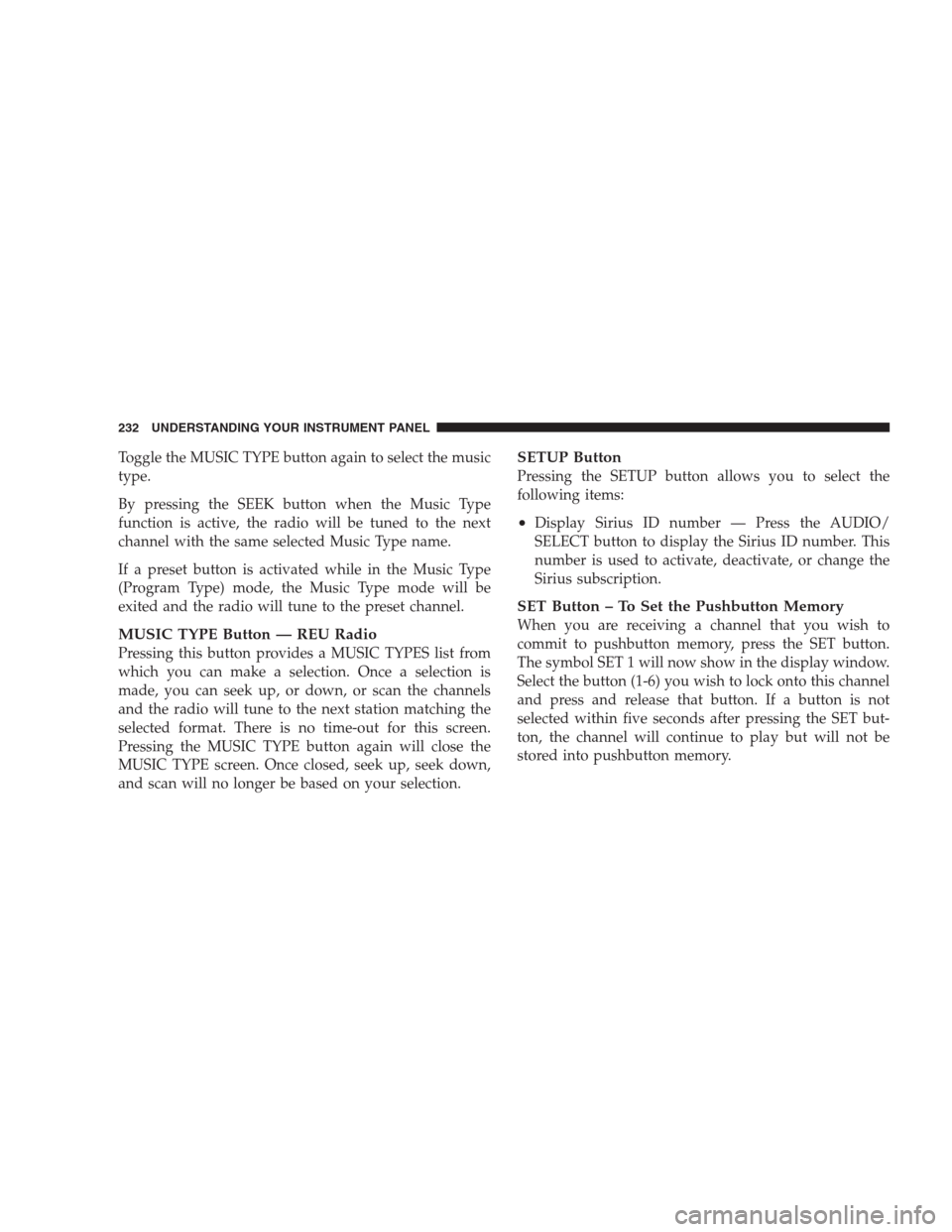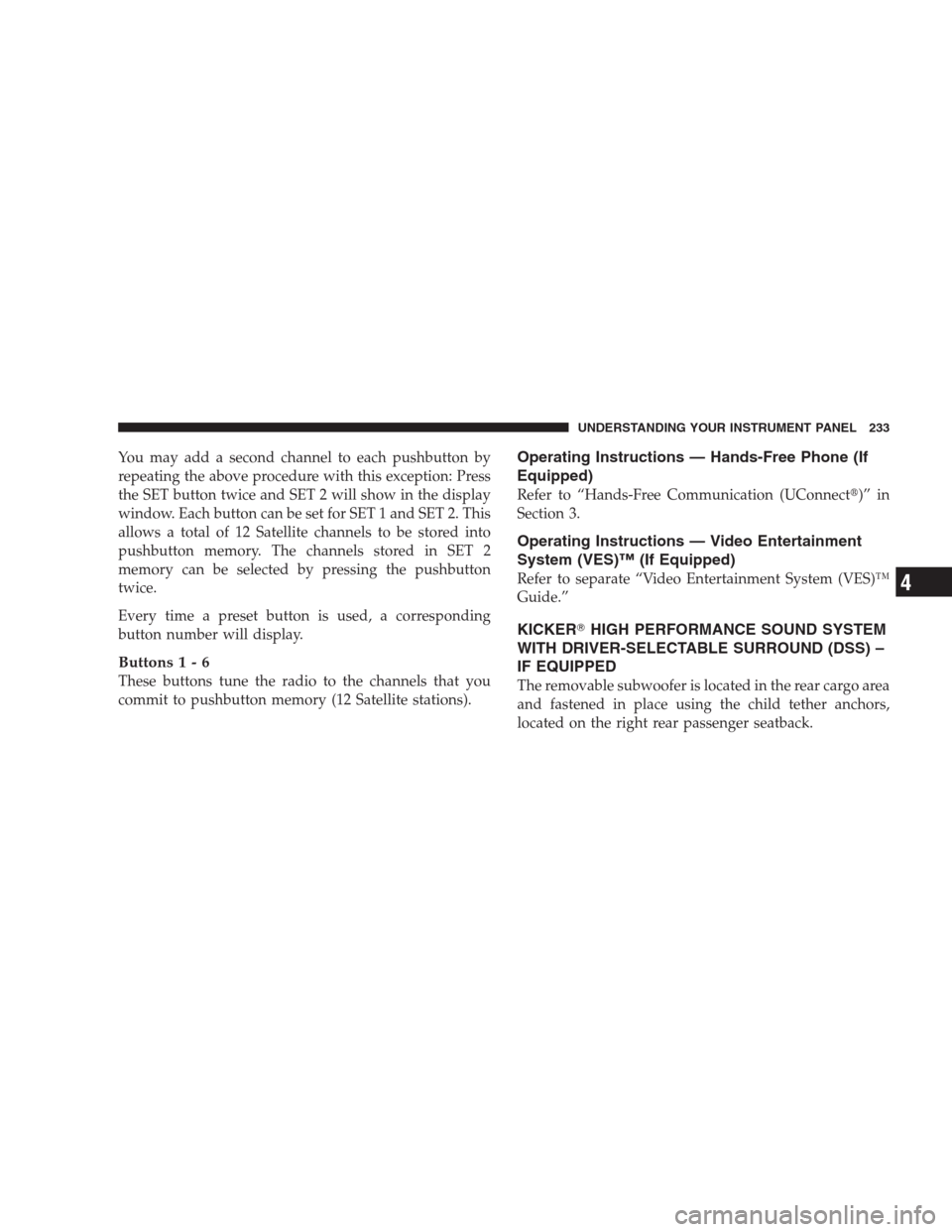Page 234 of 411

Toggle the MUSIC TYPE button again to select the music
type.
By pressing the SEEK button when the Music Type
function is active, the radio will be tuned to the next
channel with the same selected Music Type name.
If a preset button is activated while in the Music Type
(Program Type) mode, the Music Type mode will be
exited and the radio will tune to the preset channel.
MUSIC TYPE Button — REU Radio
Pressing this button provides a MUSIC TYPES list from
which you can make a selection. Once a selection is
made, you can seek up, or down, or scan the channels
and the radio will tune to the next station matching the
selected format. There is no time-out for this screen.
Pressing the MUSIC TYPE button again will close the
MUSIC TYPE screen. Once closed, seek up, seek down,
and scan will no longer be based on your selection.
SETUP Button
Pressing the SETUP button allows you to select the
following items:
•Display Sirius ID number — Press the AUDIO/
SELECT button to display the Sirius ID number. This
number is used to activate, deactivate, or change the
Sirius subscription.
SET Button – To Set the Pushbutton Memory
When you are receiving a channel that you wish to
commit to pushbutton memory, press the SET button.
The symbol SET 1 will now show in the display window.
Select the button (1-6) you wish to lock onto this channel
and press and release that button. If a button is not
selected within five seconds after pressing the SET but-
ton, the channel will continue to play but will not be
stored into pushbutton memory.
232 UNDERSTANDING YOUR INSTRUMENT PANEL
Page 235 of 411

You may add a second channel to each pushbutton by
repeating the above procedure with this exception: Press
the SET button twice and SET 2 will show in the display
window. Each button can be set for SET 1 and SET 2. This
allows a total of 12 Satellite channels to be stored into
pushbutton memory. The channels stored in SET 2
memory can be selected by pressing the pushbutton
twice.
Every time a preset button is used, a corresponding
button number will display.
Buttons1-6
These buttons tune the radio to the channels that you
commit to pushbutton memory (12 Satellite stations).
Operating Instructions — Hands-Free Phone (If
Equipped)
Refer to “Hands-Free Communication (UConnect�)” in
Section 3.
Operating Instructions — Video Entertainment
System (VES)™ (If Equipped)
Refer to separate “Video Entertainment System (VES)™
Guide.”
KICKER�HIGH PERFORMANCE SOUND SYSTEM
WITH DRIVER-SELECTABLE SURROUND (DSS) –
IF EQUIPPED
The removable subwoofer is located in the rear cargo area
and fastened in place using the child tether anchors,
located on the right rear passenger seatback.
UNDERSTANDING YOUR INSTRUMENT PANEL 233
4
Page 236 of 411
Installing Subwoofer
1. Align the right outside edge of the subwoofer with the
outside edge of the rib located on the load floor.2. Slide the subwoofer toward the front of the vehicle so
that the rear edge lines up with the end of the load floor.
NOTE:The left outside edge of the subwoofer will not
line up with a rib on the load floor.
3. Connect the electrical connector.
234 UNDERSTANDING YOUR INSTRUMENT PANEL
Page 237 of 411
4. Fold the right rear passenger seat rearward into the
upright position. The rear tether anchors should engage
the hooks located on the back or the subwoofer.
5. Check the subwoofer for being securely fastened to the
seatback.
WARNING!
Always remove the subwoofer from the vehicle
whenever the tether anchors behind the subwoofer
are required for proper installation of a child re-
straining device. In the event of an accident, or under
severe vehicle maneuvers, leaving the subwoofer
unsecured in the vehicle could result in serious or
fatal injury to anyone in the vehicle.Removing Subwoofer
1. Fold the right rear passenger seatback forward to
unlatch the subwoofer.
2. Disconnect the electrical connector.
3. Open the liftgate and remove the subwoofer.
UNDERSTANDING YOUR INSTRUMENT PANEL 235
4
Page 238 of 411
REMOTE SOUND SYSTEM CONTROLS — IF
EQUIPPED
The remote sound system controls are located on the rear
surface of the steering wheel. Reach behind the wheel to
access the switches.The right-hand control is a rocker type switch with a
pushbutton in the center. Pressing the top of the switch
will increase the volume and pressing the bottom of the
switch will decrease the volume.
The button located in the center of the right-hand control
will switch modes to Radio or CD.
The left-hand control is a rocker type switch with a
pushbutton in the center. The function of the left-hand
control is different depending on which mode you are in.
The following describes the left-hand control operation in
each mode.
Radio Operation
Press the top of the switch to SEEK up for the next
listenable station. Press the bottom of the switch to SEEK
down for the next listenable station.
Remote Sound System Controls
236 UNDERSTANDING YOUR INSTRUMENT PANEL
Page 239 of 411

The button located in the center of the left-hand control
will tune to the next preset station that you have pro-
grammed in the radio preset pushbuttons.
CD Player
Press the top of the switch once to go to the next track on
the CD. Press the bottom of the switch once to go to the
beginning of the current track or to the beginning of the
previous track, if it is within one second after the current
track begins to play.
If you press the switch up or down twice it plays the
second track, three times, it will play the third, etc.
The button in the center of the left-hand switch changes
CD’s on the 6–Disc in-dash CD changer radio. This
button does not function for all other radios.
CD/DVD MAINTENANCE
To keep a CD/DVD in good condition, take the following
precautions:
1. Handle the disc by its edge; avoid touching the
surface.
2. If the disc is stained, clean the surface with a soft cloth,
wiping from center to edge.
3. Do not apply paper or tape to the disc; avoid scratch-
ing the disc.
4. Do not use solvents such as benzene, thinner, cleaners,
or antistatic sprays.
5. Store the disc in its case after playing.
6. Do not expose the disc to direct sunlight.
7. Do not store the disc where temperatures may become
too high.
UNDERSTANDING YOUR INSTRUMENT PANEL 237
4
Page 240 of 411

NOTE:If you experience difficulty in playing a particu-
lar disc, it may be damaged (i.e. scratched, reflective
coating removed, a hair, moisture or dew on the disc)
oversized, or have theft protection encoding. Try a
known good disc before considering disc player service.
RADIO OPERATION AND CELLULAR PHONES
Under certain conditions, the cellular phone being ON in
your vehicle can cause erratic or noisy performance from
your radio. This condition may be lessened or eliminated
by relocating the cellular phone antenna. This condition
is not harmful to the radio. If your radio performance
does not satisfactorily “clear” by the repositioning of the
antenna, it is recommended that the radio volume be
turned down or off during cellular phone operation.
CLIMATE CONTROLS
Climate Controls
The Climate Control System allows you to balance the
temperature, amount, and direction of air circulating
throughout the vehicle. The controls are located on the
instrument panel, below the radio.
238 UNDERSTANDING YOUR INSTRUMENT PANEL
Page 241 of 411
The air conditioning system of your vehicle contains
R-134a, a refrigerant that does not deplete the ozone layer
in the upper atmosphere.
The controls are as follows:
Mode Control (Air Direction)
The mode control allows you to
choose from several patterns of air
distribution. You can select either
a primary mode, as identified by
the symbols, or a blend of two of
these modes. The closer the con-
trol is to a particular mode, the
more air distribution you receive
from that mode.
Panel
Air is directed through the outlets in the instrument
panel. These outlets can be adjusted to direct airflow.
Bi-Level
Air is directed through the panel and floor outlets.
NOTE:There is a difference in temperature between the
upper and lower outlets for added comfort. The warmer
Climate Control Location
UNDERSTANDING YOUR INSTRUMENT PANEL 239
4